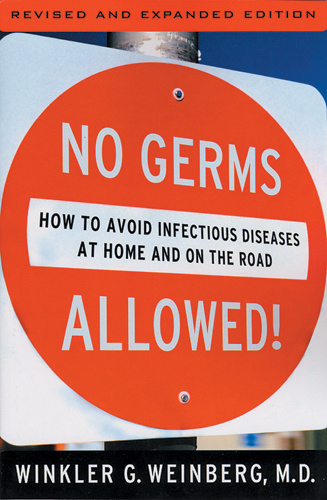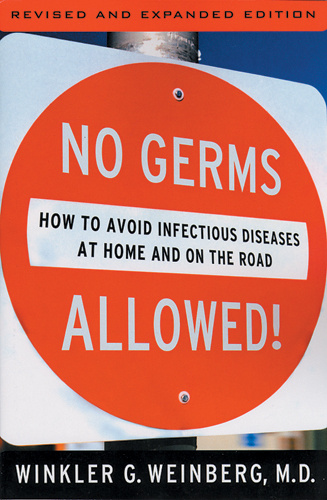
No Germs Allowed!
How to Avoid Infectious Diseases At Home and on the Road
AIDS, tuberculosis, hepatitis, chickenpox, malaria, Lyme disease, salmonella, strep throat-no matter where you go or where you live, you are at risk from infectious disease. But there are ways you can protect yourself and your family!
The revised and expanded edition of this classic guide explains what you need to know to keep the germs away. From the infections of daily life, like the common cold and traveler's diarrhea, to dangerous, rare diseases such as plague, hantavirus, and invasive strep bacteria, to recent threats of mad cow disease, West Nile virus, SARS, and bioterrorism, this unique guide tells you:
- your chances of getting sick
- simple precautions you can take
- which vaccinations and shots are worthwhile
- how to avoid catching infections in the hospital
- special precautions to take if you are pregnant
- how to ward off infections even if you have chronic health problems or are HIV positive
- how to keep well while traveling
- what to eat-and not eat-on the road
- symptoms that signal trouble
- what illnesses you can get from bug bites and animals
- how to prevent sexually transmitted diseases
- who should get flu shots and why
- why you should see your doctor before you get sick
Dr. Winkler G. Weinberg lets you know what you need to worry about and what you don't.
An enjoyable, well-written, very clear book, which provides a great deal of information for the lay public.
An enjoyable, well-written, very clear book, which provides a great deal of information for the lay public.
Among infections, upper respiratory tact infections (URIs) are the most common, although they're rarely serious. Whenever surveys are taken of households in the United States, URIs are by far the most frequent medical problem reported. The average preschool child has six to ten URIs each year and adults have two to four of them each year. Women, probably because of their exposure to young children, get more URIs than men. Millions of visits are made to doctors, millions of days are lost from work, and billions of dollars are spent on remedies for URIs every year.
A URI, though, is not one particular disease. Many-actually, hundreds-of different kinds of germs, mostly viruses, can infect your nose, throat, and other parts of your upper airways. But the most frequent offender is a tiny virus called the rhinovirus. (Rhino is Greek for nose.) This tiny virus causes the most typical form of what we call the common cold.
As its name implies, a typical rhinovirus infection will primarily torment you in your nose. This virus grows best in the somewhat cooler temperatures found there; it grows poorly at core body temperature (at 98.6 degrees F or 37 degrees C), so it does not invade deeper structures. An infected nose runs a clear or mucoid fluid and feels not only congested but blocked. The tip of the nose may turn red as well. A sore or scratchy throat is common, cough and hoarseness are not infrequent, but actual fever (over 100 degrees F) is unusual. You can expect to improve in three or four days and get over a rhinovirus infection mostly in about a week, with some exceptions. (If you smoke, then the illness, especially the cough, may be prolonged.) On the tail end of a rhinovirus infection you become likely to develop sinusitis or an ear infection. The sinuses and ears must drain freely into the nose and throat in order to remain uninfected, and the swelling that occurs with a cold can block those passageways.
The set of symptoms that I've described for you characterizes the common cold, and most often, the common cold is a rhinovirus infection. However, many of the other viruses and some of the bacteria that cause URIs can mimic this picture. More often, they're less characteristic; the variations in symptoms of URI are innumerable. Much of what we know, though, about how one gets a URI relates particularly to rhinovirus and is thanks to the studies of Dr. Jack Gwaltney, an experimental virologist at the University of Virginia. Much of what I'm going to say about transmission comes from his work.
Rhinovirus is seasonal. Most years, especially on the East Coast, many people tend to catch cold in the fall, usually in September. Another but less prominent wave of colds often occurs in March, April, or May. These may be the common cold seasons because they are also the wet seasons, and rhinoviruses survive better outside our bodies when the humidity is high. Also, we spend more time indoors then: children go back to school in September, and as we congregate, we facilitate the spread of the virus. Contrary to popular belief, the increase of colds in the fall is probably not directly related to the weather. Volunteers exposed to cold temperatures show no more susceptibility to rhinovirus infection than their comfortable counterparts do. People of all ages get colds, but children and young adults get the most.
You can pick up a cold from anyone with whom you share close quarters. You are much more likely to catch a cold at home or at school than you are at work, at the mall, or on the train. How does rhinovirus get from one person to another? First, it gets on your hands. Then, you rub it into your eyes and nose. In the course of our daily activities, we are constantly touch- ing our eyes and our nose, often unknowingly: this is normal behavior (see figure 1.1). But if rhinovirus is present on our hands, it can be the start of a cold. How does the rhinovirus get to your hands in the first place? You can pick it up when you touch another person (for example, shake hands or care for a child) or touch something in your immediate environment (the doorknob, for example, or the telephone). Rhinovirus can survive for over twenty-four hours on objects and surfaces.
Hand-to-nose transfer of germs may be the most common way to get colds, but you can also catch a cold through the air. A geyser of large and small particles will erupt from an uncovered sneeze or cough (see figure 1.2). These particles can directly infect you by landing in your eye or in your nose, or they can contaminate the surfaces you will soon touch. Let me make some suggestions-some readily apparent- about how not to catch rhinovirus colds. Naturally, you should encourage people with colds to cover their mouth and nose well when they cough and sneeze. They should be using disposable tissues. Depending on how vigilant you want to be, it may be helpful to use a germicide to clean household surfaces that you suspect have become contaminated. Frequent hand washing or use of a hand sanitizer is also a good idea, whenever hands may have been contaminated.
It would be wonderful if these were a safe and inexpensive substance you could take to prevent colds. Unfortunately, such a brew has not been concocted. But naturally, when two-time Nobel Prize winner Linus Pauling published Vitamin C and the Common Cold in 1970, people were ready to believe. At that time, headlines were made, and vitamin C (ascorbic acid) became so popular that pharmacies were unable to maintain adequate supplies. However, no experimental data were available, only theories. Now, decades and fourteen studies later, it had been clearly shown that vitamin C (ascorbic acid) does not prevent a cold. It is also of little use, if any, in treating a cold.
However, just as retractions never have the impact of erroneous headlines, I know that some readers will remain unshaken in their conviction that they feel better and are less ill with respiratory illnesses when they drink orange juice or take vitamin C. They should be careful not to overdo it. Vitamin C in megadoses (more than two grams per day) can lead to kidney stones. Everything from A to Z has been tried for the common cold, but there is no good evidence that any of them, from aspirin to echinacea to zinc, will be of any benefit.
Tables and figures
Acknowledgments
Introduction: At risk
Part One: The infections of daily living
1 The common cold
2 Strep throat and other strep infections
3 Urinary tract infections
4 Infections of the skin
Part Two: Infections you get from your environment
5 Lyme disease and other tickborne infections
6 Food poisoning
7 Health hazards of travel
8 Pneumonia and Legionnaires' disease
Infections you get from others
9 Tuberculosis
10 Sexually transmitted diseases
11 Hepatitis
12 HIV infection and AIDS
Part Three: Persons with unique risks
13 Special persons and special situations
14 How to avoid infections if you have HIV
15 If you are pregnant
16 In the hospital
Part Four: Twenty-first-century infections
17 Emerging infections
18 Bioterrorism
Appendixes
A Vaccination schedules
B Antibiotics to prevent infective endocarditis
C Rabies
Bibliography
Index




